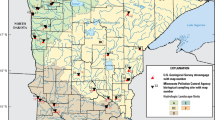Abstract
An assessment of the ecological condition ofsouth Florida estuaries based on regional probabilisticmonitoring was conducted during the summer of 1995. Samples anddata were collected on water and sediment quality, benthos, andfish tissue contaminants. Elevated concentrations of metals andpesticides were measured in both sediments and fish tissue withsome exceedances of guidance values. Bottom dissolved oxygenlevels over 23–37% of the area were below state criteria. Eighty-eight percent of surface waters had greater than10% penetration of ambient light to a depth of 1.0 m. Ninepercent of the area studied in South Florida exhibited degradedbiology and impaired use based on a calculated index ofecological condition. Using the probability-based monitoringdesign, useful information of this type can be provided toresource managers regarding estuarine condition on a regional scale.
Similar content being viewed by others
References
Boesch, D. F. and Rosenberg, R.: 1981, ‘Response to Stress in Marine Benthic Communities'. In: G. W. Barret and R. Rosenberg (eds), Stress Effects on Natural Ecosystems, John Wiley & Sons, New York, pp. 179–200.
Braun-Blanquet, J.:1932, Plant Sociology: The Study of Plant Communities, (Transl. rev. and ed. by C. D. Fuller and H. S. Conard), Hafner, London, 439 pp.
Engle, V. D., Summers, J. K. and Gaston, G.: 1994, ‘A benthic index of environmental condition of Gulf of Mexico estuaries',Estuaries 17(2), 372–384.
Engle, V. D. and Summers, J. K.: 1999, ‘Refinement, validation, and application of a benthic indexfor Northern Gulf of Mexico estuaries, Estuaries 22(3a), 624–635.
Engle, V. D.: 2000, ‘Application of the IndicatorEvaluation Guidelines to an Index of Benthic Condition for Gulf of Mexico Estuaries'. In: L. E. Jackson, J. C. Kurtz and W. S. Fisher (eds), Evaluation Guidelines for Ecological Indicators, EPA/620/R-99/005 U.S, Environmental Protection Agency, Office of Research and Development, Research Triangle Park, NC.
Florida Department of Environmental Protection: 1996, Surface Water Quality Standards,62–302, 530.
Food and Drug Administration, Shellfish Sanitation Branch: 1971, National shellfish register of classified estuarinewaters. Northeast Technical Services Unit: Davisville, RI.
Fournie, J. W., Summers, J. K. and Weisberg, S. B.: 1996, ‘Prevalence ofgross pathological abnormalities in estuarine fishes', Trans. Amer. Fish. Soc. 125, 581.
Governors Commission for a Sustainable So.Florida: 1995, Initial Report, October 1 1995, 189 pp.
Hyland, J. L., Balthis, L., Hackney, C. T., McRae, G., Ringwood, A. H., Snoots, T. R., Van Dolah, R. F. and Wade, T. L.: 1998, Environmental quality of estuaries of the Carolinian Province: 1995. Annual statistical summary for the 1995 EMAP-Estuaries Demonstration Project in the Carolinian Province. NOAA Technical Memorandum NOS ORCA 123 NOAA/NOS, Office of Ocean Resources Conservation and Assessment, Silver Springs, MD, 143 p.
Livingston, R. J.: 1990, ‘InshoreMarine Habitats'. In: Ronald L. Myers and John J. Ewel (eds), Ecosystems of Florida, University Presses of Florida, Gainesville, FL, pp. 549–572.
Long, E. R., MacDonald, Smith, S. L. and Calder, F. D.: 1995, Incidence of adverse biological effects within ranges ofchemical concentrations in marine and estuarine sediments, Environ. Manage. 19, 81.
Kannan, K., Smith, R. G., Lee, R. F., Windom, H. L., Heitmuller, P. T., Macauley, J. M. and Summers, J. K.: 1998, ‘Distribution of total mercury and methyl mercury in water, sediment, and fish from South Florida estuaries, Arch. Environ. Contam. Toxicol. 34, 109–118.
Macauley, J. M., Summers, J. K. and Engle, V. D.: 1999, ‘Estimating the ecological condition of the estuaries of the Gulf of Mexico', Environ. Monit. Assess. 57(1), 59–83.
Macauley, J. M., Engle, V. D., Summers, J. K., Clark, J. R. and Flemer, D. A.: 1995, ‘An assessment of water quality andprimary productivity in Perdido Bay, a Northern Gulf of Mexico estuary', Environ. Monit. Assess. 36, 191–205.
Nauen, C. E.:1983, Compilation of Legal Limits for Hazardous Substances in Fish and Fishery Products, FAO fisheries Circular No. 764, Food and Agriculture Organization of the United Nations, Rome, Italy, 102 pp.
Scott, G. I., Fulton, M. H., Kucklick, J. R. and Thayer, G.: 1995b,'An Ecotoxicological Assessment of Pesticide and Urban Nonpoint Source Runoff into Florida Bay and Surrounding Environments'. In: R. J. Brock, J. C. Cato and W. Seaman (organizers), Florida Bay Science Conference: A Report by Principal Investigators, 17 and 18 October 1995, Gainesville, Florida. Abstracts and program. NPS, NBS, NOAA, USGS, FWS, COE, FKNMS, FDEP, and SFWMD, pp. 34–36.
Sokal, R. R.and Rohlf, F. J.: 1981, Biometry, W. H. Freeman and Company, New York, 859 pp.
Summers, J. K.: 2001, ‘Ecologicalcondition of the estuaries of the Atlantic and Gulf Coasts of the United States', Environ. Toxicol. Chem. 20(1), pp. 99–106.
Summers, J. K., Paul, J. F. and Roberson, A.: 1995, ‘Monitoring the ecological conditions of estuaries in the United States', Toxicol.Environ. Chem. 49, 93.
United States Department of the Interior – United States Geological Survey: 1996, Mercury and Periphytonin the South Florida Ecosystem. FS-184-96.
U.S. EPA.: 1995, EnvironmentalMonitoring and Assessment Program (EMAP):LaboratoryMethods Manual – Estuaries, Volume 1: Biologicaland Physical Analyses. US Environmental Protection Agency, Office of Research and Development, Narragansett, RI, EPA/620/R-95?008.
Washington, H. G.: 1984, ‘Diversity, biotic and similarity indices', WaterRes. 18(6), 653–694.
Zieman, J. C.: 1982, The Ecology of the Seagrasses of South Florida: A Community Profile, U.S. Fishand Wildlife Services, Office of Biological Services, Wash., D.C. FWS/OBS-82/25, 158 pp.
Author information
Authors and Affiliations
Corresponding author
Rights and permissions
About this article
Cite this article
Macauley, J.M., Summers, J.K., Engle, V.D. et al. The Ecological Condition of South Florida Estuaries. Environ Monit Assess 75, 253–269 (2002). https://doi.org/10.1023/A:1014800217354
Issue Date:
DOI: https://doi.org/10.1023/A:1014800217354




